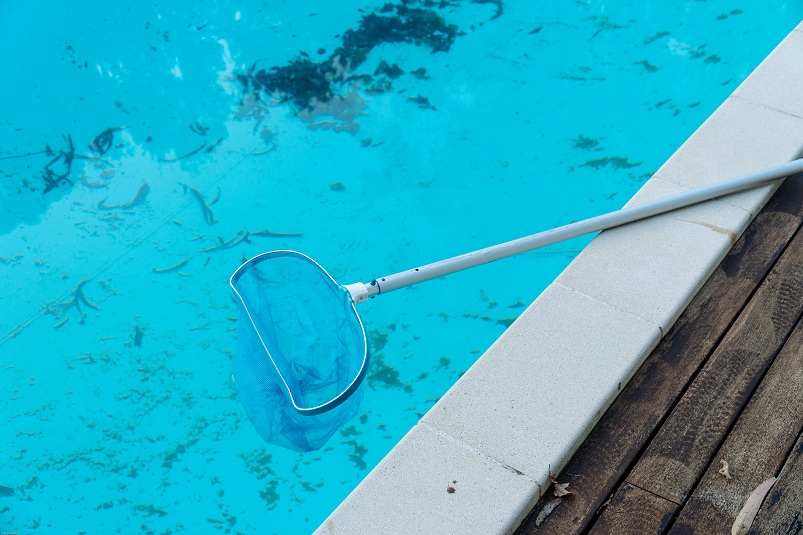A swimming pool is one of the most beautiful places to spend time with your family and friends. However, cleaning the bottom of the pool is essential to maintaining a clean pool. If you do not regularly clean the bottom of the pool, you may spend hours trying to remove the dirt from the bottom.
You can use several methods to clean the bottom of the swimming pool. Some of these methods include using chemicals, scrubbing brushes, and vacuuming. Each method has its advantages and disadvantages.
What Causes Stains On My Pool Floor?
Stains on pool floors are caused by many different things. The most common causes include:
1. Metals & minerals leaching out of your pool water into the surface. Hard water can cause calcium buildup on a gunite pool surface, for example.
2. Rust from attached ladders and other accessories in or near the pool.
3. Organic chemicals & biological materials found in nature, such as acidic leaves, bugs, algae and bacteria, are chief culprits.
Each cause requires a different type of cleaning solution. But the cleaning method is roughly the same.
Preventing Stains
The most effective way to remove stains from your pool is to prevent them from forming in the first place.
There are two types of chemicals that you can use to keep your pool from developing stains: chlorine and bromine.
Chlorine and bromine are the best ways to prevent biological organisms from growing in your pool. Chlorine is used to kill bacteria and algae. Bromine is used to kill algae. Both of these chemicals are safe for humans and pets.
However, there are some drawbacks to using chlorine and bromine.
The most important concern is that these two chemicals must be lept within a safe range of concentration in your pool water or they will damage the surface of the pool and/or your eyes, hair, and skin.
Materials and Gear To Keep Pool Surfaces Clear
The following products and pool gear are commonly used by cleaning professionals and home owners to keep their pool surfaces clean, bright, and free from stains.
Pool Brush
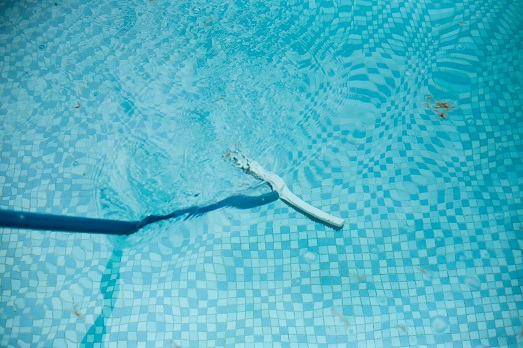
Scrubbing pool brushes are the easiest and most common way to remove dirt, stains, and grime from the bottom of your swimming pool. No pool owner should be without one.
Pool brushes are made out of nylon bristles to protect soft pool surfaces from etching and damage. Never use a metal brush on a pool surface – it can damage the pool or tear a liner.
The bristles are attached to wide brush on the end of a long extendable pole. The bristles are designed to be placed into the water and moved back and forth across the bottom of the pool to loosen up any dirt.
Automatic Pool Vacuum
Another option that you can use to keep your pool surfaces clean to to vacuum the bottom of the pool on a weekly or monthly basis.
Vacuuming the bottom of a pool with a suction-side pool cleaner or a robotic pool cleaner will remove any debris that falls into the pool each day, plus the debris you loosen using a pool brush.
Chemicals: Stain and Organism Removers
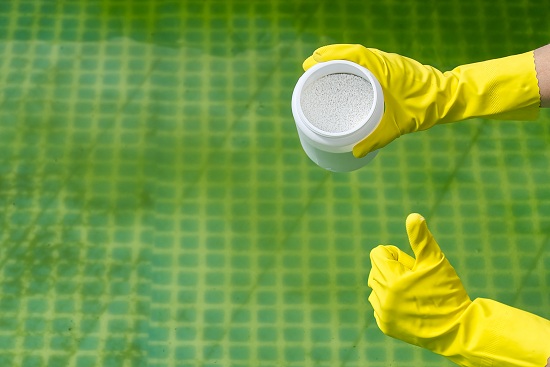
Each of the causes of stains listed above – metals/minerals, rust, and organisms – requires its own special cleaning and stain remover.
If the problem is algae, you will need to figure out which type of algae is the problem before buying the correct type of algaecide to remove it.
The most common forms of algae are green and black. Make sure you get the right cleaner and use the correct cleaning procedure for each.
If you use chemicals to clean the bottom, ensure you follow all safety precautions. For example, never mix different types of chemicals.
Always read the label on the container before mixing the chemicals. Also, always wear gloves when handling chemicals.
Finally, ensure that you store the chemicals properly, so they do not leak or spill.
Weekly Pool Cleaning Regimen For Pool Surfaces
Step 1 – Brush the pool sides.
Brush the walls of the pool first. Then, brush the floor of the pool. Finally, make sure that you brush the entire bottom of the pool. You want to eliminate any dirt that may be stuck between the tiles
Step 2 – Scrub With A Pool Brush To Loosen Debris
Clean the bottom of the pool with a scrubbing pool brush ($20-$50) to loosen and remove stuck on debris.
Start at one end of the pool and work toward the other.
Move the brush slowly along the bottom of the pool and build piles of debris as you go.
Do not move too fast or you will end up spreading the debris everywhere, which will complicate the next step – removal.
Step 3 – Remove Loose Debris with a Pool Net
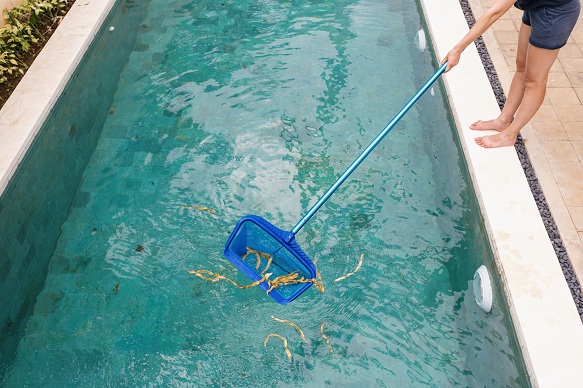
Use a pool net ($20-50) to remove larger debris that might fall into the water each day.
To remove loose debris from the bottom of a pool, we recommend a specific method that has worked for us forever.
Start by placing the net into the water with the leading edge of the net flush with the surface of the pool before starting each stroke.
Push, don’t pull, the net along the pool floor into and beneath the debris to scoop it into the net as it drags through and under the pile. Most pool nets are designed with a shovel-shaped leading edge to facilitate this.
Then, as you finish each stroke, gently lift the net upwards to the pool’s surface. This will apply water pressure to trap the debris in the net until you remove the net from the water.
Dump the debris into a trash can, and repeat until the debris is gone.
Step 4 – Vacuum the Pool Floor
Usually, pool nets are not capable of picking up finer debris like sand and small organic pieces.
To remove this, use a suction-side pool vacuum or a robotic pool cleaner to vacuum loose fine debris remaining on the pool’s surface. If you use a robotic pool cleaner, make sure you install the finer mesh filter before starting this.
Repeat steps 1-4 every week to keep the bottom of the pool looking good.
What Makes a Pool Dirty?
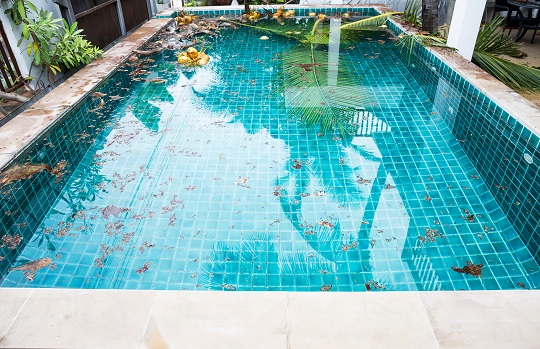
Aside from the three major causes of stains, several other things can cause a pool to become dirty. Some common causes include:
Leaking Pumps
Pools that have leaking pumps often have algae growing on them. Leaks occur when the pump does not seal tightly against the pool wall.
Foul Water
When the chlorine levels in the water are too high, the water becomes foul-smelling. Foul water smells like rotten eggs. It also contains bacteria and algae.
Inadequate Chlorine Levels
Inadequate chlorine levels can lead to algae growth. The best way to ensure that your pool has adequate chlorine is to test the water regularly.
Improper Maintenance
You should check the filter system once a month. First, check the filters to see if they are clogged. Replace the filters if necessary.
Incorrect pH
You should also check the pH level of the water. If the pH level is below 7.2, then you need to add more acid to raise the pH level. If the pH level exceeds 8.0, you need to lower the amount of acid added.
How to Keep Your Pool Bottom Free of Stains and Debris
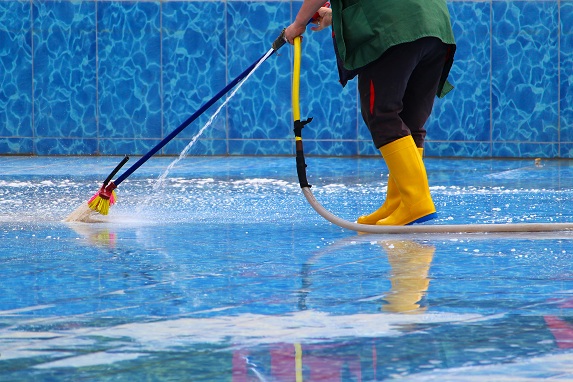
To prevent your pool’s bottom from becoming covered with debris, you will need to perform regular maintenance. Here are some tips on how to keep your pool bottom free of debris:
Maintain Proper pH Level
The proper pH level helps to control the growth of algae. To maintain the correct pH level, use only chemicals specifically designed for swimming pools.
Check the Filter System Regularly
The filter system removes solid waste from the water. If the filter system fails to function appropriately, debris may be floating in the water. You can determine whether the filter system works by testing the water.
Keep an Eye Out for Algae Growth
Algae growth occurs when the water is not filtered properly. When this happens, the water becomes cloudy. This makes it difficult to determine whether or not the water is safe to swim in.
Clean the Walls of the Pool Regularly
Cleaning the pool walls helps reduce the amount of algae that grows on the walls. Use a hose to spray the walls with a cleaning solution. Then, rinse off the walls using fresh water.
Remove Any Scum Forming Bacteria
Scum-forming bacteria create a film on the surface of the water. This film prevents sunlight from reaching the water. As a result, the water turns green. Remove scum by adding a few drops of bleach to the water.
FAQs
Q: How do I know if my pool needs to be cleaned?
A: A dirty pool is often a bit cloudy or emits unpleasant odors. If the pool water color is green or surfaces become yellowed or greenish in hue, then it’s time to clean your pool.
Q: What is the difference between saltwater and a chlorinated pool?
A: Saltwater pools contain salt that is used to generate chlorine – instead of adding all of the chlorine by hand. Saltwater pools require less chlorine and are therefore better for your skin, health, eyes and the surface of your pool. That said, they require additional equipment and salt to function.
Q: Why is my pool looking murky?
A: Excess algae growth is the most common cause of a murky pool.
Q: How often should I change or clean my pool filter?
A: Change or clean your pool filter once per month.
Q: How much does it cost to have a pool professionally cleaned?
A: Professional pool cleaners charge anywhere from $50 to $150 per hour. Depending on the size of your pool and the details that need attending to, expect the job to take 1-3 hours to complete.
Q: Is it better to have a professional clean my pool or do it myself?
A: It depends on what kind of service you are seeking. If you want a thorough cleaning, then hiring a professional is recommended. On the other hand, if you want to get rid of the gunk that has built up over time, then doing it yourself is fine.
Q: Can I buy pool supplies at home improvement stores?
A: Yes, you can purchase pool supplies at home improvement centers. But when it comes to treating special kinds of problems like black algae, calcium/mineral deposits, and rust stains we recommend talking to a local professional pool store before you buy anything. A local pool pro can help you diagnose exactly what sort of problem is causing your stains before you purchase products that may not work.

